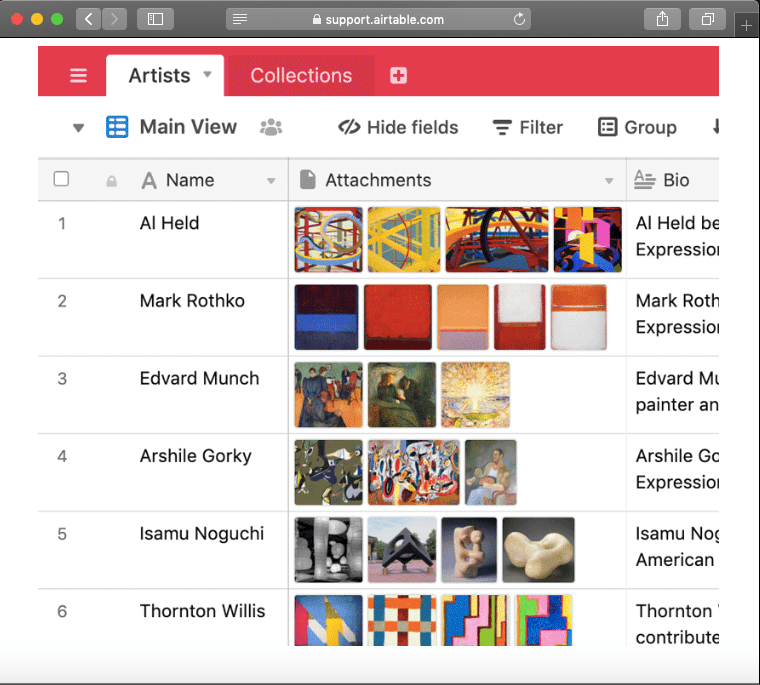Is Airtable the right tool for you?
When it first arrived on the scene back in 2012, Airtable was the cool kid on the block in project management circles.
But does it still get as many high-fives as it did a decade ago?
And more importantly, can a spreadsheet really be a project management solution?
This Airtable review will help you answer these questions to decide if it’s the best project management software for your team.
We’ll cover its features, pros and cons, as well as the Airtable pricing plans, to give you a comprehensive review of the app.
Let’s get started.
What is Airtable?

Airtable is an easy-to-use database and spreadsheet software. It lets you add “records,” or cells of data, to a comprehensive data table. This grid view serves as your default Airtable workspace.
Essentially, Airtable takes the best features of an Excel or Google Sheets spreadsheet and presents them in a simple user interface!
An Airtable spreadsheet can help a user:
- Manage inventory data
- Track lists of reference items
- Build a makeshift CRM software
Who can use it?
As Airtable’s user interface is essentially a blank canvas with grids, almost anyone can use it. It’s the perfect database for a user who wants to track inventories or simple to-do lists!
What are the key features of Airtable?
Airtable offers pre-made templates, custom views, doc storage, task management and tracking.
...so what made this tool so popular?
Here’s a closer look at Airtable’s best features:
1. Pre-made templates to help you quickly create your first Airtable base

As setting up the Airtable workspace can be really complex for new Airtable users, the software provides hundreds of pre-made templates to help you out.
These templates range from personal projects to conventional business themes, such as:
- “User Research”
- “Social Media Campaigns”
- “Bug and Issue Tracker”
Regardless of what you use an Airtable database for, you can find pre-made templates that’ll cater to your needs in the Airtable universe.
2. Custom views for different applications
The Airtable app lets you create different custom Airtable views, like the Calendar view, to help you adapt to your team’s needs.
These include:
- Classic spreadsheet: displays a spreadsheet/ grid view similar to Excel and Google Sheets

- Calendar: the Calendar view displays Airtable records according to date columns, like submission dates

- Gallery: card-oriented view that shows file attachments like images and documents

- Kanban: a Kanban board is a popular stacked-card format used in Agile project management tools like Trello and ClickUp

Note: While the tool supports all these Airtable views, it lacks a basic Gantt chart view — something every Agile project needs.
Bonus: Coda Vs. Airtable
3. Document storage keeps project files in one place

Airtable lets you store various file attachments in your database records.
You get storage spaces ranging from 2GB to 1000GB in various pricing plans. This way, you can save your project data within your Airtable base without running out of space.
Yeah, no need to declutter just yet!

The Airtable app also supports multiple formats for your file attachments like:
- Images and videos
- PDF documents
- Spreadsheets, including support for a CSV file
4. Task management and tracking
In the days of yore, people used Excel and Google Sheets for project management!
This was before the era of any dedicated project management tool — most of them now being Airtable alternatives.
And if listening to Queen or Phil Collins isn’t enough to bring back memories, you can create a basic task management system with the free Airtable spreadsheet or grid view.
You can use the tables in your Airtable workspace to enter task data, like how long someone spends on a task. This way, you get quick overviews of project statuses, provided you manually update it on a regular basis.
For added flexibility, you can also share the Calendar view with your teams to plan and manage project timelines and to-do lists.
But wait.
Why would anyone still use a spreadsheet for project management when you now have dedicated project tools?
I don’t know either!
But Airtable is for those people.

5. Airtable blocks can integrate third-party plugins
Third-party plugins that support Airtable integration are called “Blocks.”
Airtable doesn’t have the essential features you’d expect in a project management app (what most Airtable alternatives offer).
Blocks let you work with plugins like Google Drive to compensate for the tool’s drawbacks.
Some of its popular integrations include:
- Slack: instant messaging and communication tool
- GitHub: software development platform
- WordPress: free open-source content management system
- Stripe: online payment processing platform
Note: The downside here is that Blocks aren’t included in the basic Airtable pricing plans. You can’t unlock the Airtable Google integrations without shelling out some major bucks.
The benefits of Airtable
So why should you use Airtable?
While the Airtable branding is basically just a good-looking spreadsheet, it does have a few benefits:
1. Adaptable to all kinds of businesses
Airtable’s user interface follows a basic spreadsheet format that can fit almost any business.
Airtable users can choose between the Airtable views that work best for them and even customize data values into several formats, like:
- Currency
- Dates
- Long text
- Preset values
You can also integrate third-party app plugins via Blocks into your Airtable database to streamline your existing workflows. Alternatively, its Zapier integration can also be used to connect to several apps.
2. Easily share files and Airtable data
To make up for the lack of team collaboration features, the tool lets Airtable users share files and data with ease. This feature is even offered in the free Airtable plan.
With desktop apps and a mobile app on iOS and Android platforms, you can access your files from anywhere. And with its great file storage limits, you can upload large files for your team to download.
When it comes to sharing your spreadsheet data, Airtable offers a few options:
- Share links with various viewing permissions
- Embed your Airtable base into your websites
- Use your base’s Airtable API key to customize your app
(all Airtable users have access to their API key through the Airtable API documentation) - Transfer your data into Google Sheets through the Airtable Importer , Zapier or other apps that support an Airtable integration
These options let you share your Airtable database or results with anyone you want to in no time!
The 6 drawbacks of Airtable
While Airtable is a handy software, it isn’t the perfect management app.
I mean, it’s basically a database management tool — not a project tool!
It’s pretty much like drinking Diet Coke.
It’s nowhere close to being like the real thing even though it acts like it is.
We all know it.
Here are 6 drawbacks of Airtable:
(click on the links to jump to a specific drawback)
- Lack of organized commenting makes collaboration difficult
- No consolidated views of all teams
- Setting up tasks (and subtasks) is complex
- No detailed reporting features
- Lacks native tracking feature
- Costly pricing model
Airtable Con #1: No organized commenting
Modern project management platforms center around real-time collaboration and feedback.
But Airtable isn’t designed for this.
Unlike the Airtable branding, the actual tool’s more of a relational database that helps represent relationships between data in a table.
What’s a relational database?
The very fact that you have to ask that shows you how complicated this entire thing is, right?
It means that Airtable doesn’t focus on easy collaboration or communication. If you want to leave a comment for your team, you’ll have to perform multiple searches to find the right record.
And we all know how fun looking through hundreds of messages is!
The only way out of this is to link Airtable to another project management software.
But what’s the point of that?

The ClickUp solution: Comment and Assigned Comments
You want to communicate with your team members, right?
You don’t need a relational database or any other super-confusing, irrelevant term.
What you need is comment sections.
Luckily, that’s exactly what ClickUp gives you.
ClickUp lets you leave comments within every task, like Slack!
Have all the conversations you need, right there!
And there’s more…
Sure, you could leave a comment asking someone to do something, but how often do people say this?

And while tearing your hair out is a totally ‘legit’ reaction to that – it’s not necessarily productive.
But don’t worry, ClickUp’s got you covered.
ClickUp’s assigned comments help you create actionable tasks out of comments for easy reviews and revisions. You can assign these to anyone in your team (including yourself).
The team member is tagged and even gets a notification for the task. The comment also appears in their task tray for easy access, until they resolve it or reassign it to someone else.
With assigned comments, you’ll never have to worry about your comments going unaddressed!
Airtable Con #2: Lack of big picture views
Here’s a few common questions that project managers ask often:
What’s the status of this task? How is it progressing? Where are my donuts?
(I’m serious! Who doesn’t want a donut?!)
When a user uses Airtable it’s virtually impossible to answer those questions and know what’s going on.
For task management, everyone must update their tables manually and give you access.
Even then, you’ll have to keep switching between each team’s tables just to find what you want!
If that isn’t going to be annoying, what is?
You’ll be wasting all this time shuffling between tables when you could be munching into a double glazed donut with sprinkles instead.
And that’s not a reasonable trade-off.
Ever.

The ClickUp solution: Custom Task Statuses
Managers need to know what’s going on in a project at all times.
They don’t have the time to go through everyone’s stuff to find out what’s happening.
To give you a quick overview of progress, ClickUp lets you add custom task statuses!
All you need is a quick look at a status to know what’s going on and then you get back to your d̶o̶n̶u̶t̶ other work!
These statuses can be customized for each team and organization.

For example, a design team may use statuses like “wireframing” and “concept,” while software development teams would rather use “review” or “issues found.” This way, anyone can check the progress with a single glance.
With a project management app like ClickUp, you can quickly and efficiently analyze progress across teams!
Airtable Con #3: Tasks (and subtasks) are near impossible to use
Sometimes a task may need more work than planned, right?
But managing tasks in Airtable is virtually impossible.
I mean, does Airtable even have tasks?
Short answer:

Long answer:
It has rows without the ability to add specific comments.
You’ll have to put in loads of effort to actually use or organize tasks — which defeats the purpose of a project management software.
And don’t even ask about subtasks!
For those, you’d have to create and link another table containing the tasks you need.
Seriously. Talk about clutter, confusion and complexity!
The ClickUp solution: Tasks, Subtasks and Checklists
ClickUp is all about taking immediate action.
You’ll find this in every task you create.
Need an update? Done
Need to assign something to someone? Done
Need to cancel something? Done
Need more sugar in your coffee? We can’t do that yet – but we’re working on it!
Tasks are the most important part of ClickUp.
That’s why you can shift tasks between lists or edit them at any time.
Subtasks add an additional layer to your structure, allowing you to define detailed goals and to-do lists inside of your tasks. Like normal tasks, you can add layers of information to subtasks such as assignees, due dates and priorities.
With ClickUp’s checklists, your team can power through a task’s completion.
ClickUp’s checklists support:
- Nesting: each checklist can hold multiple sub-items to help you get as detailed as you want
- Drag and Drop functionality: easily move items to reschedule your list
- Assigning Items: assign list items to specific team members
- Templates: create checklist templates that can instantly be added to your projects
With so much customization over every detail, you’d think you were in charge of filming a period drama!

Airtable Con #4: Absence of detailed reporting features
Airtable doesn’t give the user detailed built-in reports.
The only reports available are basic graphs and reports via Airtable Blocks, which are too costly.
In Airtable, you have practically no way to analyze your project progress to know if things are proceeding according to plan!
The ClickUp solution: Powerful Reporting Functionalities
ClickUp has tons of powerful reporting features to keep you up to date with your project progress.
And when we say tons, we mean it.
There are more charts than the number of sequels in the Fast and Furious franchise!

The tool’s built-in Gantt Chart View let you stay on top of your projects easily. You only need a quick glance to know how your projects are moving.

And that’s not all.
ClickUp’s charts automate several processes in real-time. Here’s a glimpse of what they can automate:
- Re-adjust dependencies based on schedule changes
- Determine project progress percentages based on completed tasks out of total tasks
- Compare the current progress against the expected progress
- Identify the critical path to know the tasks you need to do to meet your deadlines
And Gantt charts are just the tip of the iceberg when it comes to reporting features!

ClickUp’s powerful Dashboards give you visual overviews of your project data.
There are tons of dashboard widgets you can choose from, like:
- Velocity charts: identifies the completion rate of tasks
- Burndown charts: highlights the team’s progress against target lines to help you analyze remaining work
- Burnup charts: highlights how much work you’ve already done against your scope
- Cumulative flow charts: tracks your project progress over time

Airtable Con #5: Lacks native time tracking
Want to know how long each task took?
In the free Airtable plan, you can’t.
You can’t make project time estimates or track time without yet another Airtable integration or add-on.
Not only is this inconvenient, but Airtable Blocks are only available in its premium plans like
the Airtable Pro plan and Enterprise plan.
You’ll have to shell out at least $20/month per user for a simple time tracking feature!
Or perhaps use your watch and punch in numbers into another spreadsheet?

Afterall, that’s exactly what you need – one more spreadsheet.
📮ClickUp Insight: ClickUp’s meeting effectiveness survey data suggests that nearly half of all meetings (46%) involve just 1-3 participants. While these smaller meetings may be more focused, they could be replaced by more efficient communication methods, such as better documentation, recorded asynchronous updates, or knowledge management solutions.
Assigned Comments in ClickUp Tasks let you add context directly within tasks, share quick audio messages, or record video updates with ClickUp Clips—helping teams save valuable time while ensuring important discussions still occur—just without the time drain! 💫 Real Results: Teams like Trinetrix are experiencing a 50% reduction in unnecessary conversations and meetings with ClickUp
The ClickUp solution: Native Time Tracking
ClickUp features a native time tracker with its Google Chrome Extension that can record the time spent on each task.

No more guessing how long a task took.
Or using your watch while creating another spreadsheet 😉
Each task also stores time in individual batches so you can see how long each person spent on the task.
What’s even better? It’s 100% FREE.
ClickUp even integrates with several time tracking tools to give you detailed insights, including:
- Time Doctor
- Pomodoro Time
- TimeCamp
- and many more!
Airtable Con #6: Expensive pricing plans
Although Airtable offers a free plan, its functionality is too limited.
As basic Airtable plans don’t allow you to use Blocks, you don’t get any time tracking or reporting features.
For essential features like Blocks or personal and locked views, your Airtable cost will rise to at least $20/month per user with the pricier Airtable plans!
Say goodbye to that vacation you planned after COVID-19 goes away!

Here’s a closer look at the Airtable cost model:
Airtable pricing model
Airtable offers you three pricing plans to choose from:
A. Airtable Free plan: free
Unlimited bases and 1200 Airtable records per base. 2GB storage per base and all views included.
B. Airtable Plus plan: $10/month per user
Includes all “Free” features, plus 5000 Airtable records and 5GB per base.
C. Airtable Pro plan: $20/month per user
Includes all “Plus” features, 50,000 records, 20GB per base and removes the Airtable branding from any Airtable form you create.
The Airtable pro plan also gives you Blocks and… more color options?

The ClickUp solution
Paying $20 or even $10 for each user on a monthly basis can quickly stack up the total Airtable cost to over $200 a month for most project teams.
I mean, why?
Why pay that much for a relational database platform like Airtable when ClickUp offers way more features at way more affordable rates?
ClickUp pricing:
Unlike Airtable plans, ClickUp offers tracking features, unlimited tasks and 24/7 customer support in the FREE plan!
And for a mere $5/month per user, you get dashboards for advanced reporting as well as integrations to streamline your project management.
This way, you have more than enough money left over for that vacation you planned, or a new laptop or a month’s supply of donuts!

Conclusion
The Airtable app isn’t a bad tool if you want a cloud-based relational database and spreadsheet software!
But that’s where its usefulness ends.
Remember, it’s not a project management tool!
Why pay for an ineffective tool when the world’s best project management app is right there, for free?
Not only does ClickUp have better versions of all the features covered in this Airtable review, it’s got tons of additional features at pocket-friendly pricing.
Whether you prefer Kanban, Scrum, or any other project management method, ClickUp’s the only tool you need!
Why not sign up for ClickUp and take it for a test-drive today?





